Economic slow down is often cyclic and a fact of life. Slowing down or crash landing of the Indian Economy is an increasing chatter on the internet. However, a closer look will reveal that the recessionary phenomenon encompasses most major economies including the US, China, Japan, Germany, the UK, France, Russia, South East Asia (the so-called ‘Tiger Economies’ of the 2000s), Brazil, Turkey, and oil-rich Gulf Nations. Latin American countries such as Venezuela, Brazil, and Argentina are acutely going through this recessionary distress with revolts and change of ruling Governments. Venezuela is undergoing severe inflation called stagflation that is spreading the contagion across the borders. Poland and Canada are amongst the only few countries that are showing flying colors despite the adverse global economic headwind.
Nations such as Pakistan, Sri Lanka, and many African countries, especially those who have subscribed to the String of Pearls (SOP), Belt and Road Initiatives (BRI), Regional Comprehensive Economic Partner (RCEP) and the 54 nations of the Africa Continent Free Trade Agreement (AfCFTA) will face a massive financial challenge while servicing the burgeoning Chinese loans. Countries such as Pakistan, are on the precipice of falling into bankruptcy. No wonder India quit the Regional Comprehensive Economic Partnership (RCEP) regional trade consortium.
The economic woes are all-pervasive and the root cause commonly follows select patterns. Individual countries have different problems. However, there is a common shared thread and select individual factors. Identifying the patterns for a specific country will help in putting up a strategy for revival. I have focused on articulating the need for a solution within broad problem areas. This blog is not exhaustive and does not go into a detailed root cause analysis or detailed solution building exercise.
Ignored Global Comparison:
In India, private debt in 2017 was 54.5 percent of the GDP and the general government debt was 70.4 percent of the GDP, total debt of about 125 of the GDP, according to the latest IMF figures. In comparison, the debt of China was 247 percent of the GDP. As of October 2018, it stands at approximately CN¥ 36 trillion (US$ 5.2 trillion), equivalent to about 47.6% of GDP. A key gauge of China’s debt has topped 300% of gross domestic product, according to the Institute of International Finance (IIF), as Beijing steps up support for the cooling economy while trying to contain financial risks. China’s total corporate, household and government debt rose to 303% of GDP in the first quarter of 2019, from 297% in the same period a year earlier, the IIF said in a report this week which highlighted rising debt levels worldwide.
In the United States, total non-financial private debt is $27 trillion and public debt is $19 trillion. More telling, since 1950, U.S. private debt has almost tripled from 55 percent of GDP to 150 percent of GDP, and most other major economies have shown a similar trend. Cumulative debt stands at 40 trillion dollars. Comparative figures from the US reveal that India is not badly hit, considering the numbers released by the Indian Government are trustworthy and credible.
Let us review select Key Performance Indices (KPI’s) of India’s financial health. Here are a few interesting figures from the State Of Indian Economy –
- GDP growth is at a 15-year low
- Unemployment is at a 45-year high
- Household consumption is at a four-decade low
- Bad loans in banks are at an all-time high
- Growth in electricity generation is at a 15-year low
The list of highs and lows is long and distressing. But the state of the economy is worrying not because of these disturbing statistics. These are mere manifestations of a deeper underlying malaise that plagues the nation’s economy today. These figures were published in the Hindu, a very reputed and respected daily. When I share independent data from foreign outlets, those are immediately ridiculed as being ‘biased to damage the growing stature of India’.
I was talking with a building contractor friend of mine who has a meaningful business. When prodded on his state of business, he said, everything is so dry and no new constructions are taking place. This is not my isolated discussion. Every now and then, I do probe these questions to people across the globe and India happens to be on the top. Below is a list of industry verticals that are not just sluggish but in recession (more than 2 quarters of slow down beyond certain percent points).
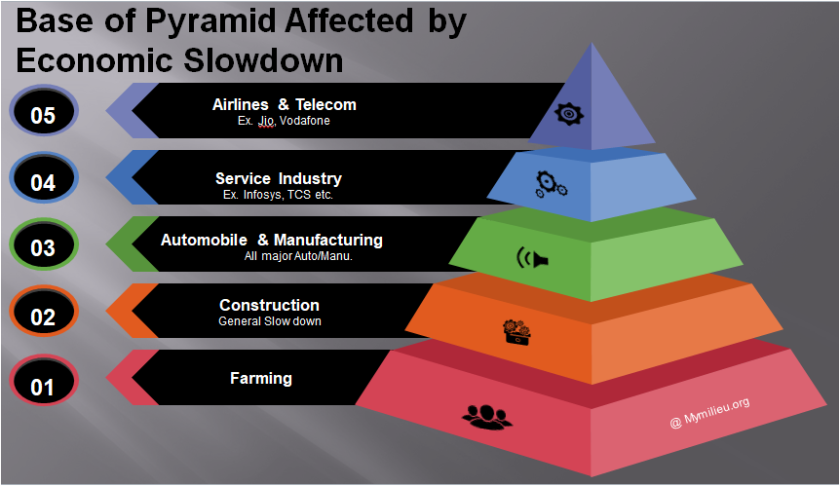
Industries Impacted:
- Manufacturing
- Farming
- Auto
- Construction
- Airlines
- Service industry
Impact Equivalence:
If you factor in the total percent affected, you will notice a major chunk of the population that forms the base of the pyramid, is affected because of the slowdown.
What happens now?
Well, families and business entities are at least losing 34-57% of their revenue. That’s a significant number. Spending goes down and tax collection goes down, tax at the POS (point of sales), tax from earning and tax from the business.
-
- Quantitative Easing
- Bad Loans or Risk prone leveraged industry
- Global slowdown
- China – A special mention
- Quantitative Easing:
Well, let us borrow now at a cheaper rate from the Govt, or blow up what is saved in RBI (exit RBI Governors), a loan or from outside or print currency.
- Bad Loans or Risk prone leveraged industry:
We can’t let this to catapult to a state of anarchy. We have to loan where the potential for defaults are high. Banking, Airlines, Telecom ate common examples. These were bankrupt overnight? The most common folks (shareholders) lost the most. Millions of crores of national treasure disappeared in just a fraction of time.
I disagree with “the Hindu” here. Let us understand, corruption was not just prevalent but endemic and all-pervasive. Nothing wrong, if Modi tightened the levers. At least he had guts to do that. No one including the system had shown responsible behavior and if Modi has tightened the noose, nothing wrong about it.
I will elaborate on the reasons where we are going wrong, needless and pointless to blame Modi for all the ills. Devaluation and GST came at a wrong time that confluence along with a Global slowdown, on which Modi had little control.
- Global slowdown:
India is not alone. China, UK, Germany, Japan, the US, France, Gulf, Russia, Brazil, and many Tiger economies (remember the term for ASEAN economies used in 2000) are significantly slowed down.
- China deserves a special mention:
China is the worst affected with 100s of ‘Ghost Cities’, flailing international trade pacts (CPEC, ASEAN and The revival of the Silk Road) and the flight of money compounded by the increasing cost of labor. It is gaining a notorious reputation of creating and exploiting poor nation’s solvency, squashing neighbors and selling obsolescence across the globe (recollect how your electrical and other goods specifically made is China have become durable and short-lasting).

What should be done?
First and foremost, Modi has to move beyond strongman to strategist. A nation survives on vision and not just statesmanship. I have identified a few areas that will help boost productivity at the individual level, jump start the GDP and improve the health of the economy.
-
- Foundational Infrastructure
- Roads and Railways
- Satellite Cities and Telecom
- Innovation in Farming
- Revamp Agricultural Supply Chain
- Environment and Pollution
- Sewage and Containment
- Social Re-Engineering
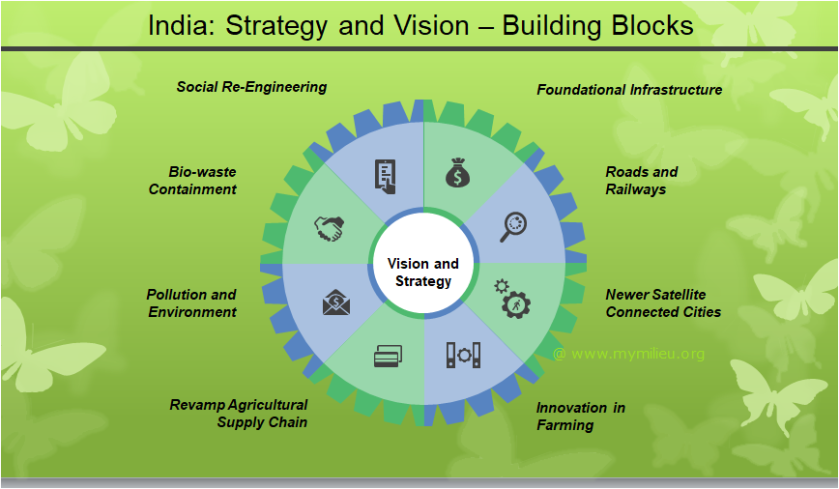
Foundational Infrastructure:
The endemic water deficiency mandates saving water, reviving rivers and building colossal connected canals for transporting water are a crucial and critical need of the growing population. It goes beyond saying that water is required for Agriculture, Industry and daily use. Lack of water will result in immediate and nationwide chaos.
Roads and Railways:
Not Airways or Bullet Trains. Though the road network is improved significantly in the last decade, it is still only sufficient for the next 5-7 years. Cities are still clogged and they will get further cluttered. Roads and rail are required first, that’s how most population and goods move across the nation. Only a few travel by Air or Bullet Train. Remember, those costly built rail networks in Africa that cost their nation a hefty and heavy loan serving overwhelming burden. India should not repeat that.
Satellite Cities with Telecom/Internet:
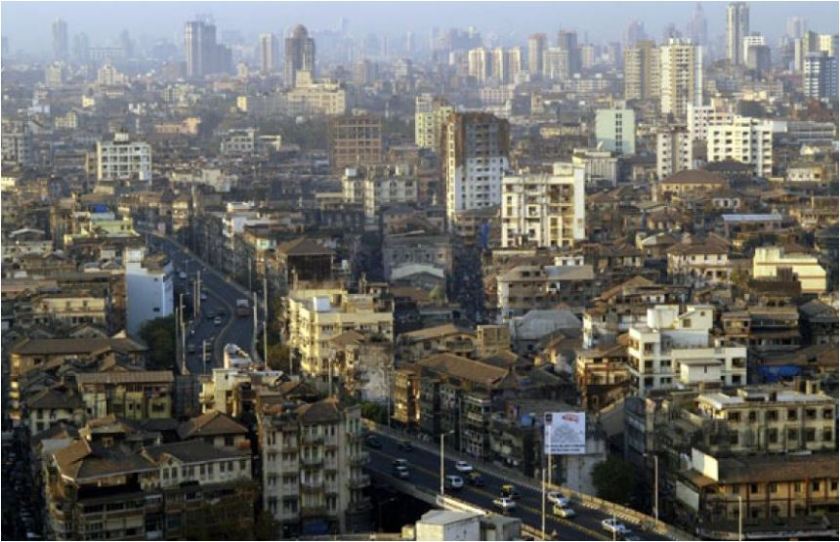
The creation of satellite cities is key to decongest and reducing the risk. We live in a connected world and to be on the forefront, the Internet and fibreoptic become a foundational utility.
Innovation in Farming:
The last major innovation in agriculture was the ‘Green Revolution’ under Lal Bahadur Shastri. Thereafter no radical change has been effected in agriculture. Other than small incremental changes to innovation in productivity, the least has been done to the farming. There is a significant need to revamp the farming supply chain. Current risk management practices are reactive and focused exclusively on disbursing cash to those drought-affected especially after an increase in suicide rates or those with inadequate production.
Revamp Agricultural Supply Chain:
Perishable crops are still creating significant damage. Overproduction is still a rampant issue. Mid and Long term storage of crop is limited to grains, very few and insufficient facilities exist for increasing the shelf life of vegetables. Though India has enough space to store grains, it lacks space or solutions for storing perishable. A solution can be increasing the value-added product infrastructure, which is missing at this moment.
Environment and Pollution:
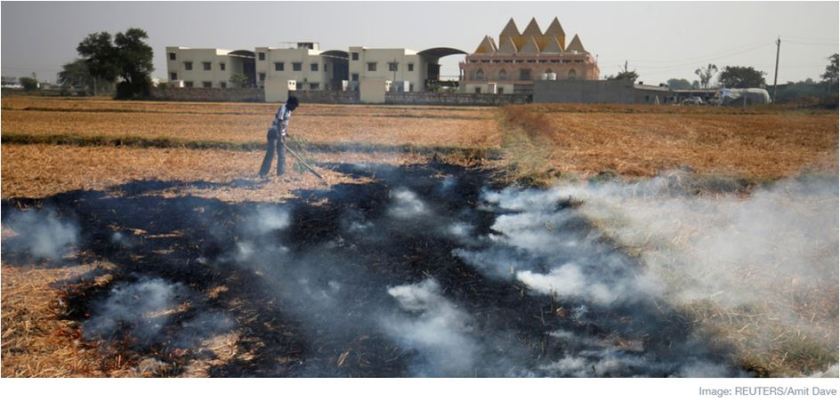
Everyone has a recollection of the ‘Delhi as a Gas Chamber’ Situation like Delhi is a commonplace across North India. Though a significant stride has been made towards harnessing solar power and unleashing the energy from nuclear (rather than coal), India’s dependence on fossil fuel is significant. To move a huge behemoth and diverse country to alternate sources of energy, India needs to invest significantly in innovations across multiple sectors.
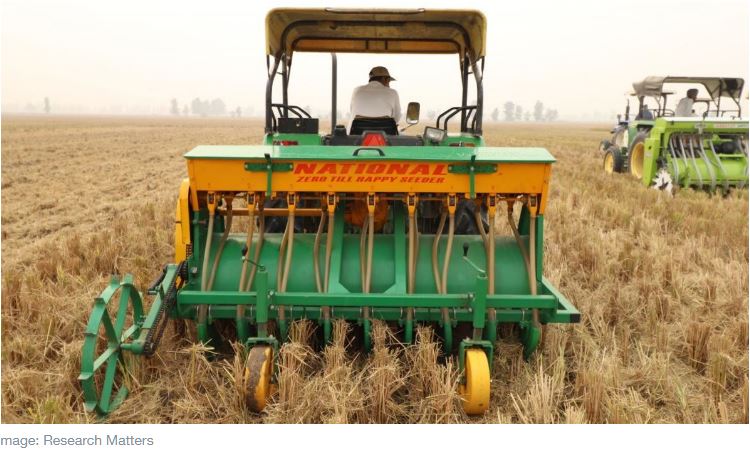
Sewerage and containment:
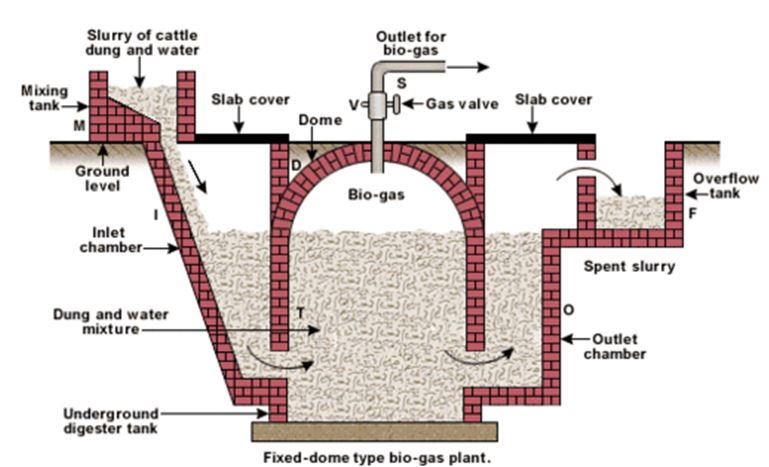
This is still a massive problem. Open defecation is a vestige of long drawn culture. Unfortunately, no institutional efforts have been made to harness gas and manure from human excrements. Namesake potties have been built to take time leverage. Both electricity and gas for industrial use can be harnessed from “Gobar Gas” plants. As a child, I still remember we had one GG Plant and it was my duty to buy cow dung on my way back from morning tuition. I would make the slurry and pour in the tank and go to school. That was 1979-80. I promise Gobar Gas Plants will never fall in disrepute, especially in the rural and semi-urban communities.
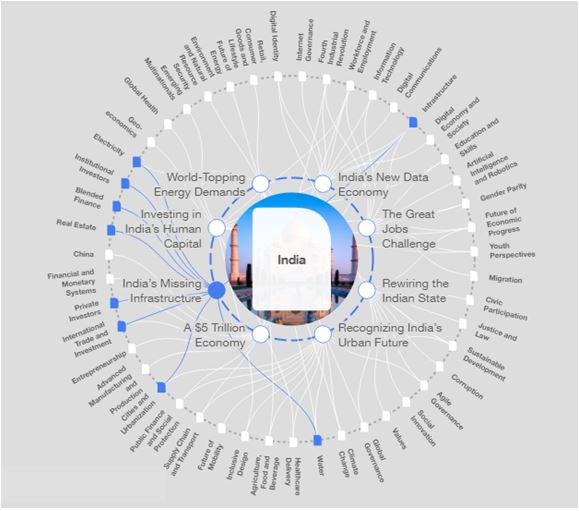
Social Re-engineering:
It is of utmost importance for a nation to find and or reinvent its own identity. India is going through those pangs right now. It is at a confluence of several mingling streams. India cannot take recluse to older achievements. If it had the potential in the past for defining humanity, it does not guarantee that it will have the same potential to influence the future of humanity or even define the potential of its nationhood. None of these factors discussed above will bring that constant trajectory of intellectual and spiritual achievement. That will only be guided by Social Re-engineering. Currently, society is defined by Facebook and What’s Up University, which in themselves are manipulated to subserve our inner mortal and material trappings.
Social engineering around several issues is a need of time. Issues such as existing in a plural world in harmony, acceptance of differing views and debate in moderation, women’s emancipation, abandoning the vestiges of ‘Chatur Varna’, adoption of a true pursuit of logical and scientific belief, bringing the inner layers into the evolving cycles of current times, creating didactic pathways that would support the emerging needs of occupations at an optimal pace are the need of the time. The list runs long however, not having a vision and a strategy is an absolutely unpardonable excuse for those in ruling the nation.
I am less worried about the current slowdown. Those are cyclic. They will occur as the tides of time will ebb and rise. However, not making concerted attempts in shaping nation-building is definitely wrong if not criminal. Accepted that the Economic currents are adverse, however, people demand creative, strategic and effective leadership to avoid stagnation, to counter the headwind. Doing so will effectively help in achieving a healthy slow landing of the economy rather than a disastrous hard landing.
Leaders of all hues and color have to collectively dedicate themselves towards these visions, irrespective of their commitment to ideologies, being in the seat of power or having the ability to influence.
A Gentle Request:
If the above makes sense to you, may I request you to spread the awareness? Finally, it is the masses that define the polity and politicians do what is the sentiment. Let us all create that positive and productive virtuous cycle of sentiments.
Shashank Heda,
Dallas, Texas
PS: I have no advertisements on my site, neither do I collect any revenue through any means. It is a passion to write and decipher events in my milieu.
More to write later…
Also, Visit – US and the World Economy here https://wp.me/p7XEWW-1A
“Art of looking for trouble, finding it everywhere, diagnosing it incorrectly and applying unsuitable remedies” – Ernest Benn. Let the polity and people prove it wrong to Ernest.
====
I disagree with below Excerpts from The Hindu below –
The root cause of this rupturing of our social fabric is the Modi government’s ‘mala fide unless proven otherwise’ doctrine of governance. The premise of the government’s policy framework seems to be that economic participants have mala-fide intent unless they can prove otherwise. This suspicion that every industrialist, banker, policymaker, regulator, entrepreneur and citizen is out to defraud the government has led to a complete breakdown of trust in our society. This has halted economic development, with bankers unable to lend, industrialists unable to invest and policymakers unable to act.
https://www.indexmundi.com/factbook/compare/india.china (An excellent head to head comparison between India and China).
https://www.weforum.org/agenda/2015/11/19-charts-that-explain-indias-economic-challenge/
From “Sabka Saath, Sabka Vikas” to “Main Bhi Chowkidar”: The forgotten macroeconomic flagships
https://www.ibef.org/economy/indian-economy-overview
Happy Seeder to reduce stuble burning – https://www.weforum.org/agenda/2019/08/stop-burning-fields-to-cut-smog-and-boost-profits-scientists-tell-indian-farmers
Floating Drum Biogas – https://www.build-a-biogas-plant.com/floating-drum-biogas/
Very well articulated, relevant and thought provoking article!! We need to re-invent our thought process in this changing world and that goes more on media (a worldwide phenomenon these days); instead of just harping on “isms” – Nationalism, Communism, Capitalism, etc. and therefore, being biased by taking sides and start blaming the other sides in almost everything (The Hindu, sadly, seems to be doing that).
The need is to look the broader picture worldwide with data/trends and then to the particular nation (and its nuances too); we would then be able to see the right picture and hence the right path. The 7 action areas are well categorized which are interconnected too by the common basic thread of “ease of reach”…. thru roads, even trains to have rapid connects of Satellite town to the mains, etc. but this will accelerate the efforts everywhere.
Once again, a very interesting article and a logical analysis!!
LikeLike
Very deeply studied article indeed focusing on past and present issues regarding socioeconomic aspects around the globe.
The analysis is fact-based and unbiased. Naturally, the ups and downs in the economies are inevitable. The future plans and its deliberation is nicely articulated.
Only one most important thing I want to link up with all this and economy is that the uncontrolled population growth in the Indian subcontinent and its consequences and adverse effects on World’s economy have a deep-rooted impact. Population explosion must be controlled as it is overburdening the limited resources.
LikeLike
A thorough analysis of the current economic situation in India. I liked that the points were supported by data, if you could add links of the reference for the numbers, it would be helpful for the reader.
I would like to see more of such articles.
LikeLike
Indeed its a very well-articulated and thought provoking article. However, my take on the slowdown is due to dampening in the US-China trade war, which has intensified over time and has contracted world trade and, in turn, Indian exports.
Also, high rates of GST, liquidity crisis in NBFCs (this has been a major culprit). Cases of IL& FS etc have drained millions of people. It could also be an “ill-conceived demonetization and the poorly executed GST roll-out” are the two key reasons behind the slowdown. I feel demonetization and GST was essentially the straw that seems to have broken the Indian economy’s back because it came at a point when the Indian economy was relatively weak.
What you have brought about are ways to revive the slowdown but to get to that stage we need to make certain staff checks on the errors made earlier.
But at the end of reading the article, one felt it had certain logic applied. However, India as a whole needs to pull up on the sine wave curve and pick up the pace.
LikeLike
Nicely articulated and backed up with proper data and logic. I do agree with you that the government should continue working on the development of infrastructure and it should be a continuous process! Definitely, there is a need to go beyond poll rhetoric and device long term plan to declutter bigger cities.
There is a need for industries to go to the doorstep of manpower and not the other way round. This will stop the labor migration to bigger cities which are already overcrowded. There is also an urgent need to work on the conservation and development of water resources. Some of these measures are not going to be very popular in terms of electoral benefits but this is needed to be done in the long term interest of the Nation!
LikeLike
Very well written and substantiated.
I think, apart from these measures, the key to rising from this slowdown is how we can convert our human numbers into assets.
Will like to see more from u…
LikeLike
Very well crafted article – As expected!
LikeLike
I agree with your views. Really good information.
LikeLike
Nice article Shashank with a lot of interesting comparisons.
Most of the countries have been enjoying a healthy economy since 2008. Economic cycle changes every 8-11 years. Currently, the world economy is at the end of that cycle. It is very hard for me to digest the below facts currently about India.
* Household consumption is at a four-decade low
* Growth in electricity generation is at a 15-year low
Indian Stock market is at an all-time high at 40,617 currently. It is hard to believe from where all this money is coming when India is under recession.
India is a huge country with a lot of challenges. India is still a developing country and there is potential for improvement in a lot of areas. I feel that a lot of good work has been done during the last 5-6 years. A lot of decisions have been finalized which were pending for so long. No political party wanted to finalize these pending tasks in the past and risk their vote bank.
India has become much more powerful in its defense. They have tackled Pakistani and Chinese threats very strongly. A lot of roads and airports have been built. A lot of government work has been digitized. A lot of middlemen have been eliminated with digitization. India’s presence in the world has improved greatly in the last 5-6 years.
I do agree with your points there are a lot of things India has to keep working to make them economically stronger and better country.
LikeLike
Very well articulated Shashank..
Really detailed with substantial data points.. Agree with your point of view (POV).. well done..
LikeLike
Well articulated with lots of insight on the key areas of focus to improve the economy.
I personally think that Modi’s govt made some brave moves like demonetization, article 370, etc. with some good intentions which no other government had taken in the past 7 decades.
Another important factor is the Reservation system in India – It has to be re-designed, it is not reaching the needy people anymore. Reservations should be implemented only in certain areas and that too not based on caste/ religion but based on the actual need. Today, because of the reservation system, most of the Govt agencies are controlled by Heads who are not competent enough, thereby unable to recommend/implement policies effectively at the gross root level even if the policies for Governance are good.
LikeLike
Excellent! Very well articulated.
You have correctly identified ‘Agriculture’ as a very important sector to beat the economic slow down and promote growth. Still, India has a 65% workforce engaged in Agriculture, so huge investment in Agri infrastructure, irrigation, research, post-harvest technology is badly needed. Don’t mind if this is at the cost of quantitative easing or loans by Govt. But this would work only if corruption is eliminated.
Further, as potable water is getting scarce, the investment needs to be done in desalination plants. India has a huge coastline, desalinated water can be used in all coastal cities and towns and even transported in interior arid zones for agricultural use. This would reduce excessive reliability on monsoon and pave the way for future food security
LikeLike